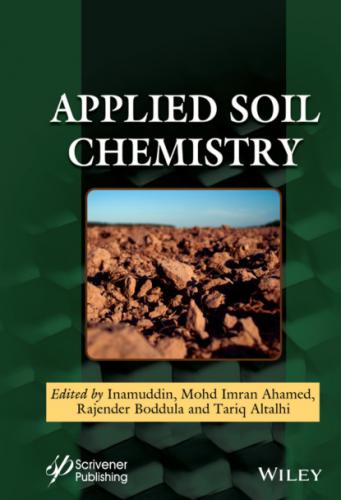2.2.2 Coarsely Grinded Minerals
According to Goldich et al., in the year 1938 [31–33], stability sequence of coarsely grained minerals was reported as (most stable first) quartz, muscovite, orthoclase, plagioclase, biotite, amphibole, and pyroxene. Marel et al., in the years 1949, 1948a, and 1947 [34–36] reported magmatic minerals stability, keeping the particle size and weathering conditions similar (most resistant first), quartz, tourmaline, rutile, staurolite, zircon, allanite, albite, microcline, orthoclase, garnet, muscovite, oligodase, andesine, bytownite, epidote, anorthite, ampjibole, augite, biotite, hypersthene, olivine, and volcanic glass. As coarsely grinded quartz is not susceptible toward weathering, it is considered as stable among all the minerals.
2.2.3 Clay Size Mineral Particles
When the size of the particles of mineral becomes finer, then the sequence of stability of mineral becomes different relative to the coarsely grinded particle of mineral. This happens due to the enhancement of specific surface which increases the process of mineral weathering, which was comparatively more stable in coarsely grinded particle size. The particle size of clay minerals is below 200 diameters. According to Jackson et al., in the year 1948 and 1952 [37–39], the sequence of weathering consisted of 13 stages for clay size particles. The sequence is in descending order of stability:
Anatase (corundum, leucoxene, ilmenite, rutile, zircon, etc.)
Hematite (limonite, goethite, etc.)
Gibbsite (also allophane, boehmite, etc.)
Kaolinite
Montmorillonite (also saponite, beidellite, etc.)
Vermiculite and silicates interstratified 1:2 layer
Muscovite (also illite, sericite, etc.)
Quartz
Albite (also orthoclase, microline, stilbite, anorthite, etc.)
Biotite (also nontronite, antigorite, magnesium chlorite, glauconite, etc.)
Olivine-hornblende (also diopside, pyroxenes, etc.)
Calcite (also apatite, aragonite, dolomite, etc.)
Gypsum (also ammonium chloride, sodium nitrate, halite, etc.)
There are few modifications in the above list. Apatite was included at calcite stage; allophane was included in gibbsite stage by Tamura et al., in the year 1953 [40–42]. Marel et al., in the year 1947, and Haseman and Marshall, in the year 1943 [43–45], included zircon in Anatase stage. Woof and Carroll et al., in the year 1951 [46–48], and Marsden and Tyler, in the year 1938 [49–51], included leucoxene in the Anatase stage.
2.3 Factors Affecting the Rate of Chemical Weathering
The rate of reaction involved in a chemical weathering is under the control wide range of capacity and intensity factors, acting as function of integration of capacity, intensity, and time. The weathering time can give rise to stage or degree of weathering. The various driving force affecting the rate of reaction involved in chemical weathering can be recognized to a extent of consideration for formation of soil are five usual factors including, time, parent material, relief, biotic forces, and climate. The conditions affecting the reaction rate of chemical weathering needs to be analyze more specifically in categories other than above listed five factors for formation of soil. Leaching effect is included in single intensity factor whether it is under the control of internal drainage, relief, rate of evaporation, distribution of rainfall, and amount of rainfall. The extent as well as the nature of leaching is collectively significant for determining the process of chemical weathering. Reduction and oxidation are specifically considered whether controlled by valence of the ions in the minerals, texture of the material, etc.
2.3.1 Capacity Factors Which Controls the Reaction Rate of Chemical Weathering
2.3.1.1 Specific Surface Role
The higher the specific surface area of the targeted mineral, the finer the size of the particle and hence very speedily it gets affected by chemical weathering processes as reported by Polynov et al., in the year 1937 [5], and Merrill et al., in the year 1906 [2]. The enhancement of the specific surface is inversely proportional to the material particle diameter. It has been reported that sequence of weathering are different in case of particle with fine size in comparison to that of coarsely sized particles. For example, due to effect of specific surface the rate of weathering of volcanic ash is faster in comparison to lava. This happens due to the larger surface area subjected for processes for weathering.
2.3.1.2 Specific Weatherability Role of Mineral
According Jackson et al., in the year 1948 [37], it was reported that the chemical weathering rate is dependent on the mineral specific nature. Minerals specific nature is highly significant for determination of rate and course of weathering, which can be arranged as per the stability of the minerals. Searle et al., in the year 1923 [52–53], reported that nature of rock significantly affected the weathering rate. As per Stephens et al. [54–56], depending on the weathering ease, there is no such considerable rock classification, with an exception for basalt which is considered as one of the rock which undergoes weathering very easily and the presence of high amount of silica causes slow weathering process. According to specific minerals, feldspars undergoes chemical weathering faster than quartz and slower than ferromagnetic minerals; calcite is more resistant to chemical weathering in comparison to gypsum. According to Goldich et al., in the year 1938 [38], it was reported that plagioclase undergoes chemical weathering faster than potassium feldspar.
2.3.2 Intensity Factors Which Drives the Chemical Weathering Reaction Rate
2.3.2.1 Factor of Temperature
The contribution of temperature in controlling the rate of reaction of weathering is identified by difference in the rate of reaction in the temperate and tropical regions. Other factors of intensity like accumulation of organic matter, hydrolysis, and leaching operation are also affected by the temperature. Stephens et al., in the year 1949 [54–56], reported that the air temperature index given by Szymkiewicz et al. in the year 1947 [57–59], T = 2.5t/10, where t represents the temperature of air in degree centigrade that is related to the chemical weathering rate. The significance of temperature on the rate of reaction
